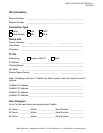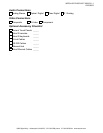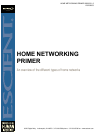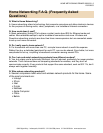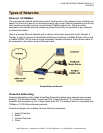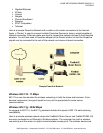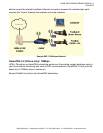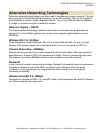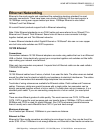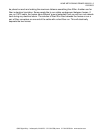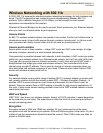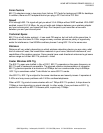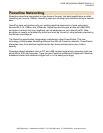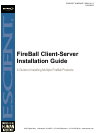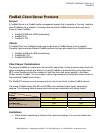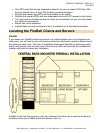
HOME NETWORKING PRIMER WD005-1-2
12/22/2003
6325 Digital Way Indianapolis, IN 46278 317.616.6789 phone 317.616.6790 fax www.escient.com
Ethernet Networking
Ethernet is the most popular and considered the networking topology standard for most
computer connections. There have been many kinds of Ethernet, but the most popular is
10/100Mbps running over copper twisted pair wires. 100Mbps Ethernet is also called
100baseT and Fast Ethernet.
All current Escient products support built-in Ethernet networking.
Note: Older Ethernet standards ran on COAX cable and were referred to as 10base2 Thin
Ethernet and 10base5 Thick Ethernet. Some hubs still have a coax connector to bridge
together twisted pair and Thin Ethernet networks.
A newer Ethernet standard called Gigabit Ethernet or 1000baseT also can run over copper
wire but hubs ands switches are VERY expensive.
10/100 Ethernet
Connections:
Connections between 10/100 Ethernet adapters are made using cables that run to an Ethernet
HUB or Switch. Hubs electrically connect your computers together and switches act like traffic
cops making your network more efficient.
When only two computers are present. A special kind of Ethernet cable can be used called a
“CROSSOVER cable.
Cables:
10/100 Ethernet cables have 8 wires, of which 4 are used for data. The other wires are twisted
around the data lines for electrical stability and resistance to electrical interference. The cables
end in RJ-45 connectors that resemble large telephone line connectors.
Two kinds of wiring schemes are available for Ethernet cables. Patch cables and Crossover
cables. Crossover cables are special because with a single cable, two computers can be
directly connected together without a hub or switch. If a cable does not say crossover, it is a
standard patch cable. If you are connecting computers to a hub or switch, you need patch
cables.
There are also different grades of cable quality. The most common are CAT5, CAT5e and
CAT6. CAT5 is good for most purposes and can transfer data at 100Mbps. CAT5e is rated for
200Mbps and CAT6 is rated for gigabit Ethernet. Run CAT5e whenever possible because
there is usually not a cost difference from CAT5 if you look hard enough.
Maximum distances:
For all twisted pair Ethernet, 100Meters is your maximum distance.
Ethernet to Fiber
Ethernet to Fiber media converters are starting to come down in price - they can be found for
under $150. When 100Meters is not enough distance, an Ethernet to fiber media converter can



